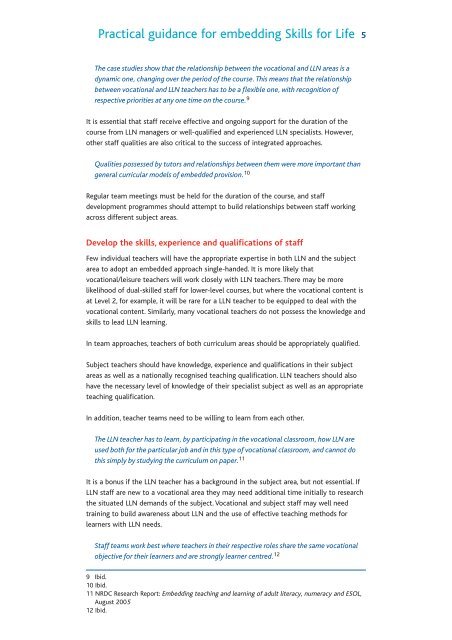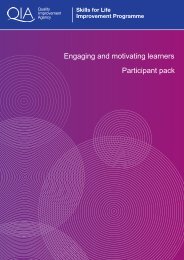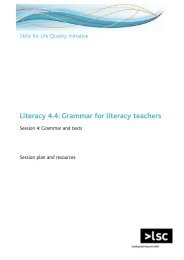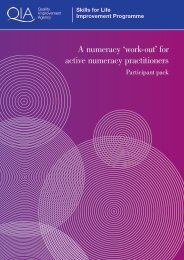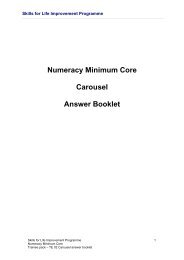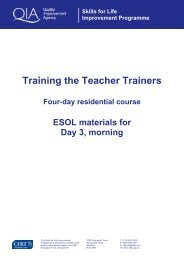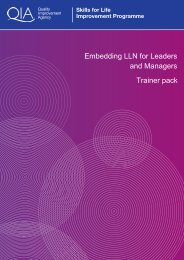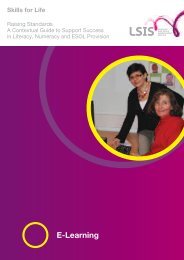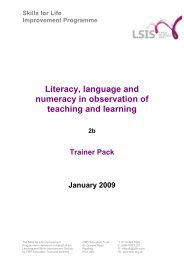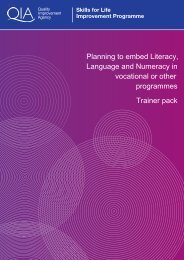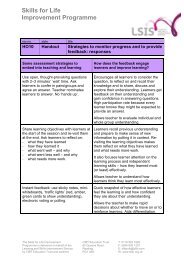Practical guidance for embedding Skills for Life - Excellence Gateway
Practical guidance for embedding Skills for Life - Excellence Gateway
Practical guidance for embedding Skills for Life - Excellence Gateway
You also want an ePaper? Increase the reach of your titles
YUMPU automatically turns print PDFs into web optimized ePapers that Google loves.
<strong>Practical</strong> <strong>guidance</strong> <strong>for</strong> <strong>embedding</strong> <strong>Skills</strong> <strong>for</strong> <strong>Life</strong> 5The case studies show that the relationship between the vocational and LLN areas is adynamic one, changing over the period of the course. This means that the relationshipbetween vocational and LLN teachers has to be a flexible one, with recognition ofrespective priorities at any one time on the course. 9It is essential that staff receive effective and ongoing support <strong>for</strong> the duration of thecourse from LLN managers or well-qualified and experienced LLN specialists. However,other staff qualities are also critical to the success of integrated approaches.Qualities possessed by tutors and relationships between them were more important thangeneral curricular models of embedded provision. 10Regular team meetings must be held <strong>for</strong> the duration of the course, and staffdevelopment programmes should attempt to build relationships between staff workingacross different subject areas.Develop the skills, experience and qualifications of staffFew individual teachers will have the appropriate expertise in both LLN and the subjectarea to adopt an embedded approach single-handed. It is more likely thatvocational/leisure teachers will work closely with LLN teachers. There may be morelikelihood of dual-skilled staff <strong>for</strong> lower-level courses, but where the vocational content isat Level 2, <strong>for</strong> example, it will be rare <strong>for</strong> a LLN teacher to be equipped to deal with thevocational content. Similarly, many vocational teachers do not possess the knowledge andskills to lead LLN learning.In team approaches, teachers of both curriculum areas should be appropriately qualified.Subject teachers should have knowledge, experience and qualifications in their subjectareas as well as a nationally recognised teaching qualification. LLN teachers should alsohave the necessary level of knowledge of their specialist subject as well as an appropriateteaching qualification.In addition, teacher teams need to be willing to learn from each other.The LLN teacher has to learn, by participating in the vocational classroom, how LLN areused both <strong>for</strong> the particular job and in this type of vocational classroom, and cannot dothis simply by studying the curriculum on paper. 11It is a bonus if the LLN teacher has a background in the subject area, but not essential. IfLLN staff are new to a vocational area they may need additional time initially to researchthe situated LLN demands of the subject. Vocational and subject staff may well needtraining to build awareness about LLN and the use of effective teaching methods <strong>for</strong>learners with LLN needs.Staff teams work best where teachers in their respective roles share the same vocationalobjective <strong>for</strong> their learners and are strongly learner centred. 129 Ibid.10 Ibid.11 NRDC Research Report: Embedding teaching and learning of adult literacy, numeracy and ESOL,August 200512 Ibid.


